You can live in Laos cheaply compared with Western countries — basic monthly costs (excluding rent) are often under $350, and a one‑bedroom in Vientiane runs around $470. Eating local food, using buses or a motorbike, and limiting air‑conditioning keep costs low. Utilities, internet and modest healthcare add another small monthly amount. If you want a higher standard, expect higher rent and occasional travel for better medical care, and more details follow below.
Cost of Housing and Rent in Laos
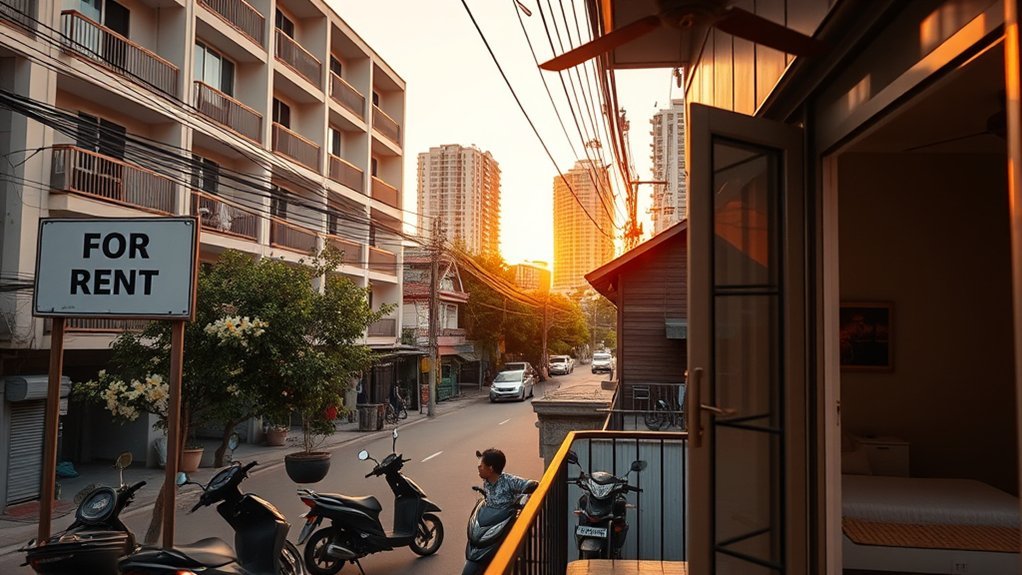
While rent varies by neighborhood, you can expect to pay about $470/month for a one-bedroom in central Vientiane, with whole houses running roughly $200–$350 and higher-end properties exceeding $300 and often coming fully furnished.
Most people sign six‑month to year‑long leases, so annual housing costs typically fall between $2,500 and $4,500 depending on location and amenities, and luxury options are available if you want more space or better facilities.
Expect six‑month to year leases — plan yearly housing costs around $2,500–$4,500, higher for luxury options.
You’ll find the Cost of Living in Laos is generally lower than in many regional capitals, but choices change your estimated monthly costs. If you prioritize central location and modern conveniences, budget toward the higher end; if you accept simpler or suburban digs, you’ll pay less.
Leases favor stability, so plan for a minimum commitment and factor utilities and occasional maintenance into your calculations. Comparing neighborhoods and inspecting furnishings will help you match rent to lifestyle without overspending.
Typical Monthly Budget Breakdown
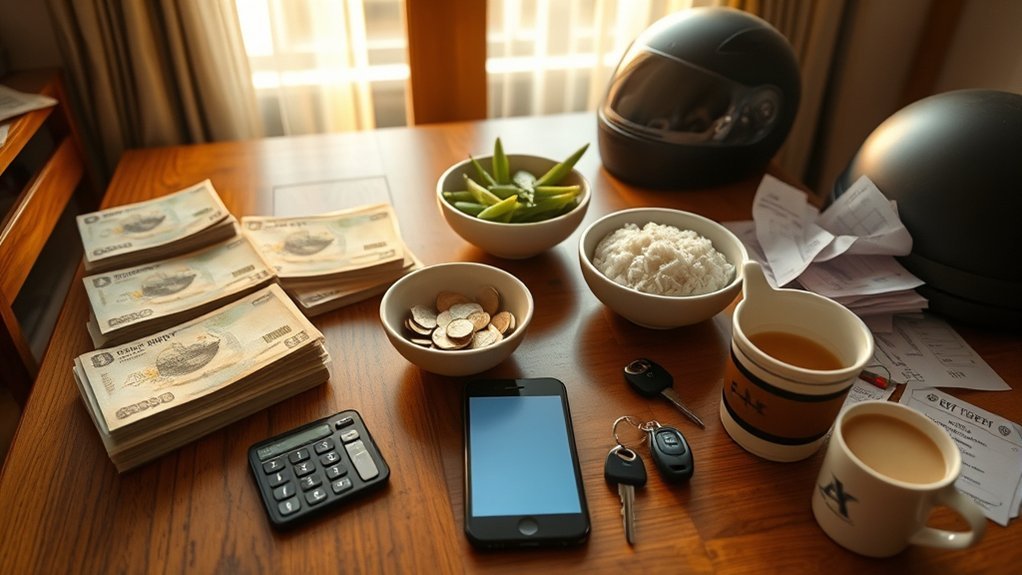
If you’re budgeting for life in Laos, expect monthly essentials to total roughly 5–5.5 million Kip ($294–$323), with food and utilities making up the bulk.
For a clear typical monthly budget, expect to pay about 3 million Kip for eating out and 1 million Kip for groceries — that splits the food line at roughly 60/20 of your essentials.
Utilities add around 250k–300k Kip for electricity; modest air‑conditioning use pushes you toward the top of that range.
That leaves room for rent (covered earlier), occasional transport, and basic incidentals within the 5–5.5M figure.
Compared to many neighboring countries, groceries and dining are inexpensive, but electricity can vary with climate and appliance use.
If you want tighter control, cut eating‑out frequency or moderate AC/heavy appliance use; doing so can lower this typical monthly budget by a few hundred thousand Kip without sacrificing comfort.
Food and Dining Prices

Eating in Laos is affordable and flexible, letting you choose between cheap street stalls, midrange cafes, or pricier international restaurants depending on your budget.
You’ll find food and dining prices that vary clearly by type: street meals cost about $1–$2 USD per plate, cheap cafes about $7 USD per person, and better foreign restaurants $10–$12 USD per person.
Local beers are cheap — a 500 ml domestic beer is roughly $1 USD — while imported 330 ml bottles run about $1.8 USD.
- Street stalls: $1–$2 USD per meal — great for daily eating, fast and local.
- Cheap cafes: ~ $7 USD per person — fuller meals, more comfort and variety.
- International restaurants: $10–$12 USD per person — Western dishes and imported beers push costs higher.
You can control spending by favoring local food; Western-style options and foreign beers noticeably increase your dining budget.
Transportation and Travel Costs
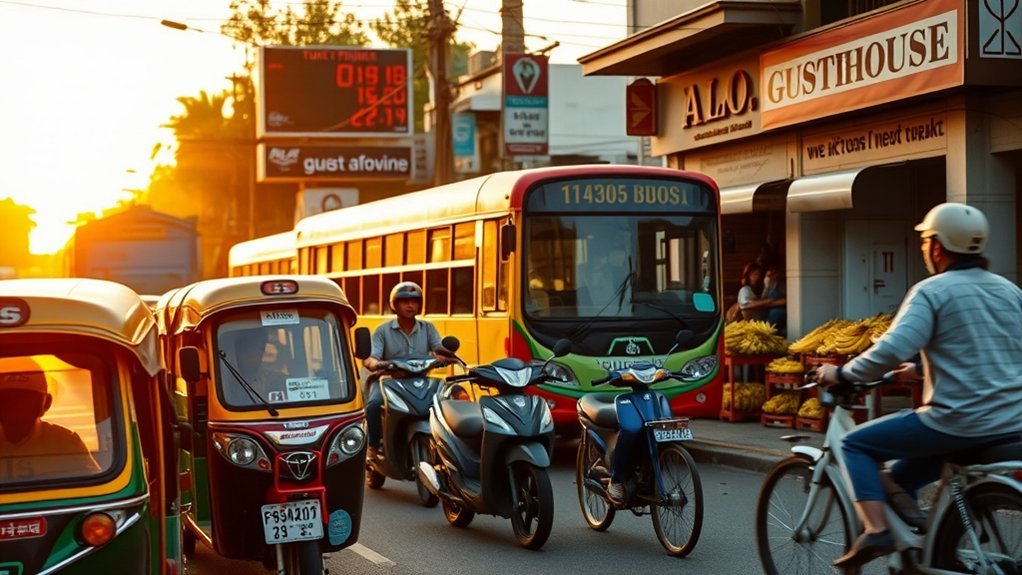
After you’ve sorted food costs, look at how you’ll get around — transport can be one of the bigger variable expenses depending on distance and comfort.
Local buses and shared tuk-tuks keep daily transport costs low; expect cheap short rides and monthly motorbike fuel bills around 200,000–250,000 Kip.
For intercity travel, buses are the norm: Vientiane to Luang Prabang runs about $40 for a 13-hour trip, while Luang Prabang to Chiang Mai is roughly $50 and takes about 20 hours. Those longer routes show how distance and road quality push prices up.
If you value time, consider flights or private transfers; they cost more but cut travel time drastically.
For budget living, plan long-haul trips sparingly and factor overnight comfort.
Compare door-to-door time, ticket price, and road conditions when estimating total transport costs — cheap fares can still mean lost days on rough roads.
Utilities, Internet, and Communication
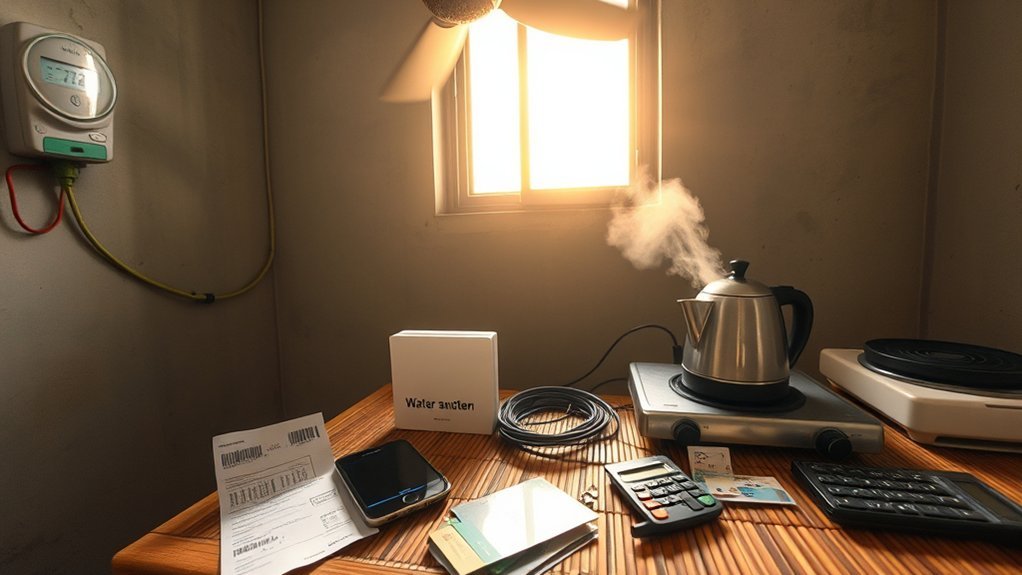
Utilities and communication costs in Laos stay relatively predictable, so you can budget them with confidence:
You’ll find monthly utilities (electricity, water, gas) typically total about 5–5.5 million Kip excluding home Wi‑Fi. Electricity runs roughly 250,000–300,000 Kip, water about 80,000–200,000 Kip, and cooking gas 300,000–400,000 Kip. Mobile and internet costs vary more.
- Mobile/internet: a basic SIM package costs ~100,000 Kip; mobile data is cheap for light users, but heavy streaming pushes you toward home Wi‑Fi.
- Home Wi‑Fi: expect 800,000–1,000,000 Kip monthly for stable broadband; that’s a clear premium compared with mobile-only plans but necessary for remote work or large households.
- Overall budgeting: if you skip Wi‑Fi, plan around 5–5.5 million Kip; add Wi‑Fi and allocate an extra 800,000–1,000,000 Kip.
You’ll compare favorably to many neighboring countries on basic utilities, though high‑speed internet raises costs.
Healthcare, Insurance, and Safety
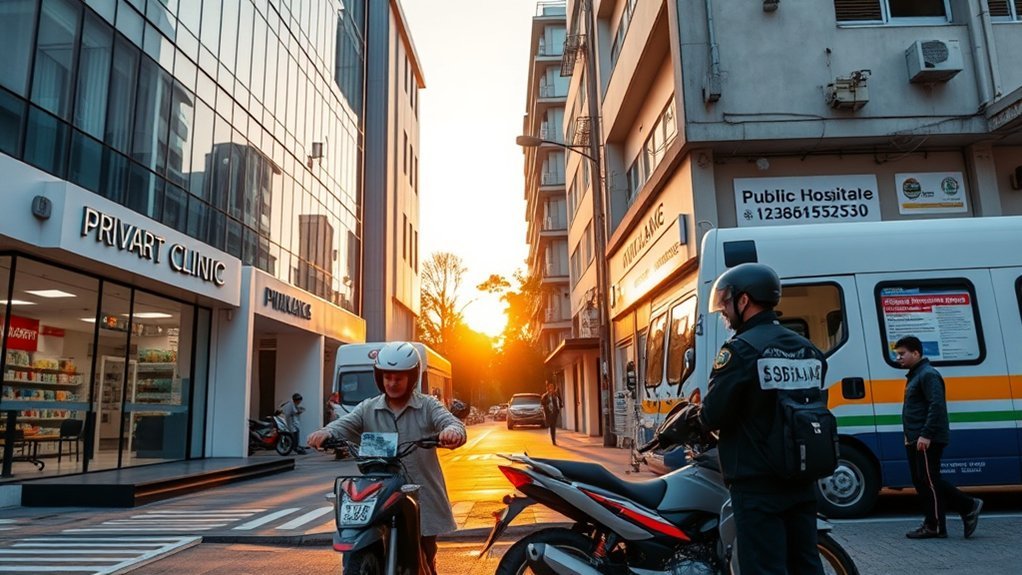
While Laos offers basic medical care for routine issues, you should plan for limited services and the real possibility of traveling to Thailand for serious treatment.
You’ll find local clinics where consultations cost roughly $10–$20, and vaccinations run about $20–$100, but specialist care, advanced diagnostics, and reliable emergency response are often unavailable or slow. For that reason, healthcare decisions here are comparative: costs are low for minor needs, but risks and gaps raise the effective price of living if you need complex care.
You should carry extensive international insurance; expatriate plans typically range $500–$1,500 annually depending on coverage and evacuation benefits.
Good insurance reduces out-of-pocket risk and gives access to private hospitals or medevac when necessary. Prioritize preventative care and vaccinations before arrival, verify policy emergency response and repatriation clauses, and budget both routine clinic visits and potential cross-border treatment to avoid surprises.
Living Standards and Local Lifestyle Considerations
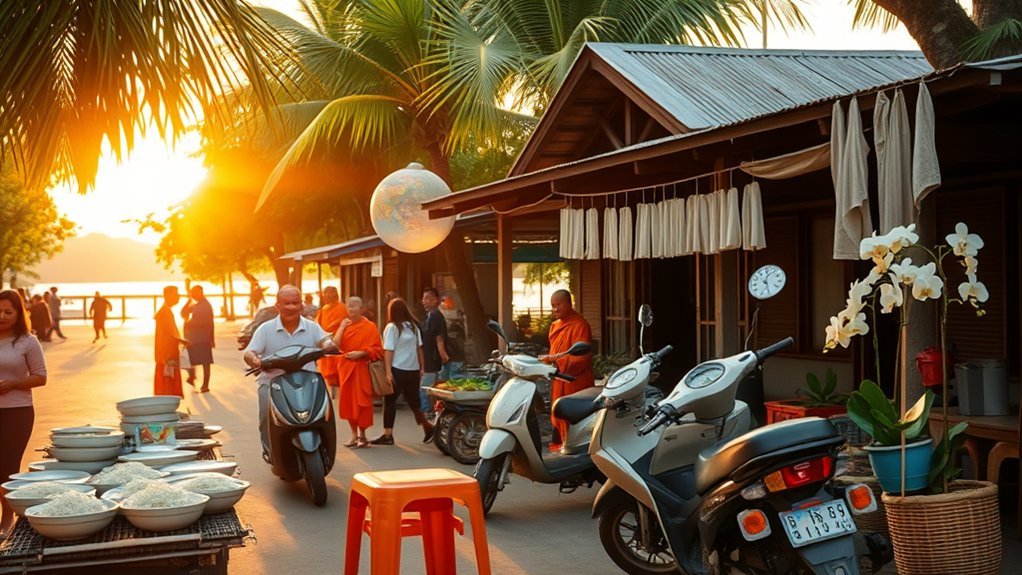
You’ll find daily routines in Laos are wallet-friendly if you stick to local markets and street food, with meals often costing $1–$2 and a comfortable monthly budget around $500–$550.
Expect simpler leisure options—tea shops, temples, and outdoor markets—compared with Western nightlife, though expat-oriented cafes and weekend trips to Thailand are common splurges.
Keep local social norms in mind (polite dress at religious sites, slower pace) to fit in and save on avoidable costs.
Daily Routines and Costs
Although daily expenses in Laos are modest compared with many neighboring countries, your routine will still shape your monthly budget: expect local restaurant meals to run about 25,000–35,000 Kip ($1–$2) each, basic utilities around 330,000–500,000 Kip ($20–$30) a month, motorbike fuel roughly 200,000–250,000 Kip monthly, and internet options from a 100,000 Kip SIM to 800,000–1,000,000 Kip for home Wi‑Fi.
You’ll use cheaper local meals and a motorbike to keep costs low, but faster internet or more electricity raises totals. A comfortable monthly budget sits near $500–$550.
Compare choices: eat local, share Wi‑Fi, or pay for convenience. Check Terms of Use for service contracts and plan to adjust habits to fit your target budget.
- Prioritize local eateries and public transport.
- Opt for basic SIM or shared Wi‑Fi.
- Monitor utilities and fuel use.
Social Norms and Leisure
Because community and family come first in Laos, you’ll find social life built around shared meals, festivals, and neighborhood ties that make fitting in straightforward compared with more individualistic countries.
You’ll spend leisure time at temples, parks, or on hikes and bike rides, activities that keep costs low and fit a relaxed pace.
In smaller towns, limited entertainment means simple pastimes — traditional games, cultural events, and neighborhood gatherings — replace nightlife and big shopping trips.
Because healthcare is basic, you’ll factor possible travel to Thailand into leisure planning and budget.
Many expats use this service of regional travel to access richer entertainment and medical care.
Understanding these terms helps you balance community immersion with occasional trips abroad.
Frequently Asked Questions
Is $100 a Lot in Laos?
You’re right to ask: $100 isn’t a lot in Laos. It’s cost effective short-term, covers basic needs for days, but won’t sustain monthly living standards; it’s practical for travel, not for comfortable long-term residence.
Can US Citizens Live in Laos?
Yes — you can live in Laos, but you’ll need to handle visa requirements (tourist extensions or business visas for long stays), register locally, and focus on cultural integration to adapt compared with other Southeast Asian expat options.
How Cheap Is Laos to Live?
Very cheap — and then surprisingly so: you’ll find a low cost of living, affordable housing options, $350 monthly basics, cheaper rents outside cities, bargain meals and drinks, so your money stretches far compared with many places.
What Is the Average Salary in Laos in Dollars?
You’ll earn about $2,150 USD average income annually in Laos. Consider economic factors like wealth inequality and informal employment; compared to neighbors, incomes are lower than Thailand’s and similar to Vietnam’s, but figures aren’t precise.
Conclusion
So you’re thinking of moving to Laos — congratulations, you’ll pay less than your coffee habit back home. You’ll trade overpriced rent for breezy wooden houses, fancy restaurants for sticky rice diplomacy, and traffic jams for occasional buffalo crossings. Healthcare’s cheaper but bring sensible insurance; internet’s fine for memes, not Netflix bingeing. Live like a savvy traveler: save, adapt, eat local, and enjoy luxury in simplicity — cheaper, calmer, and oddly charming.


